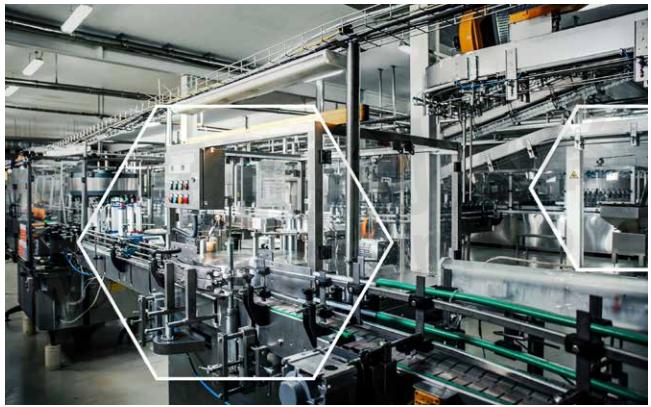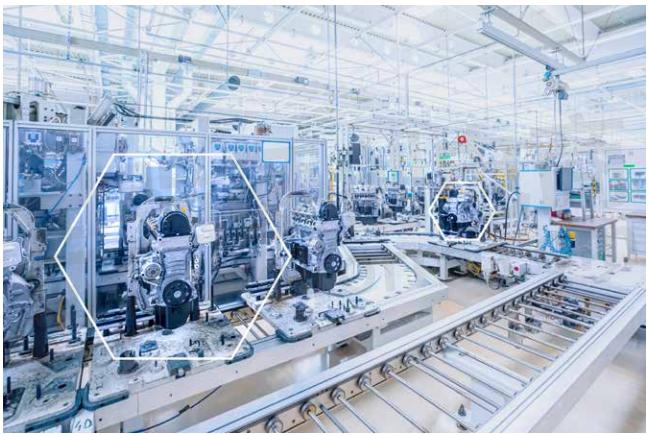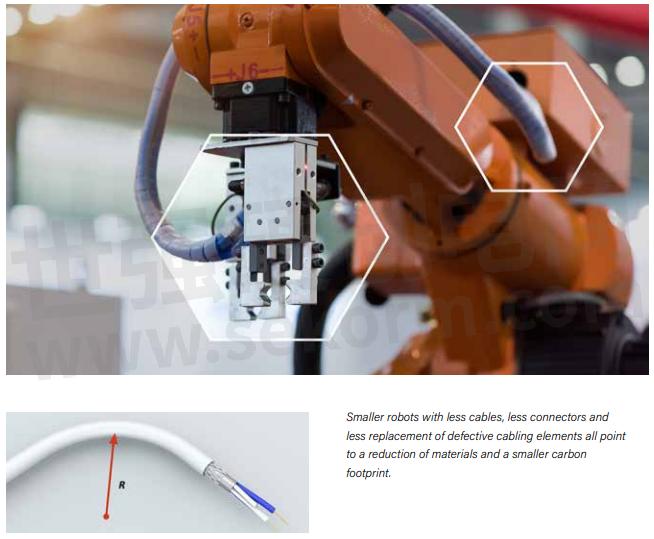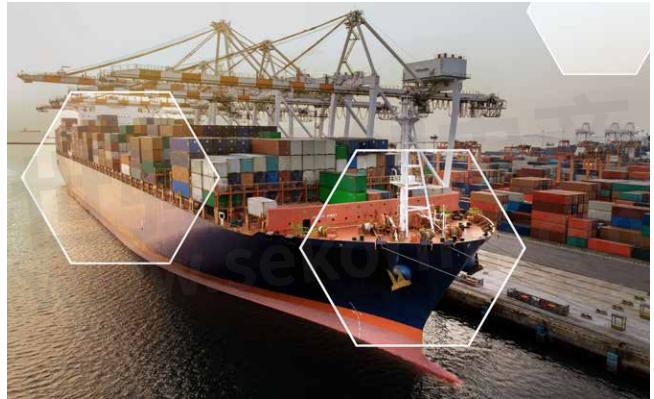Single Pair Ethernet System Alliance

Across the market, ethernet has long served as a backbone for networking in applications. However, the advent of digitalization and the Internet of Things (IoT) yield an increase in the density of sensors and a corresponding demand in communication SPEed and seamlessness. This marks a shift in the role of ethernet – it no longer complements serial fieldbus communication protocols, but replaces them in the future.
A good example of this is the industrial plant. This area historically featured an ethernet networking
backbone and a collection of fieldbus systems at the field level. With the need to replace fieldbuses with a more efficient communication sub-system, the emergence of the Industrial Internet of Things
(IioT) overthrew this established order. A similar shift can be observed in any market or application
area featuring communication both at the sensor and network levels, e.g. smart cities, the healthcare
(r)evolution with the IoMT (Internet of Medical Things), protection strategies, or vehicle modernization.
For all these purposes, seamless communication is crucial.
Fast ethernet needs two pairs of wires, and gigabit ethernet and above require four pairs. Meanwhile,
Single Pair Ethernet (SPE) works with only one pair of wires, providing power as well as data. Its
transmission rates – 10 Mbit/s with a maximum transmission length of 1,000 m up to 1 Gbit/s with a
maximum transmission length of 40 m – are completely sufficient even for the most sophisticated
sensor technology. Scanners and cameras can also be integrated with it.
Single Pair Ethernet represents a great solution for all high-speed IP networks. It is ideal for
application fields where maximum bandwidth is less important than saving space and long-distance
communication. While the various application areas might require different physical installations,
buildings, outdoor applications and various industries can all benefit from SPE in the future.
With Single Pair Ethernet, a new standard is established that enables the necessary miniaturization
and long cable runs. With a connection technology suitable for industrial use, it is possible to create a
continuous connection from the sensor all the way up to the cloud.
Another major advantage is the possibility of supplying power to the connected peripherals via the Power
over a Data Line (PoDL). PoDL provides up to 60 W at the Power Source Equipment (PSE) for power
supply. Like this, the sensor system can be supplied with both power and a data interface even in
extremely compact environments. There is no need for additional, separate supply lines.
Application Fields and Use Cases for Single Pair Ethernet
One great advantage of Single Pair Ethernet is the seamless IP-based communication from the sensor to the cloud. This makes data available throughout the entire process chain of production, which can create huge added value for service, process optimization, logistics, etc. in the smart factory. The following examples demonstrate how strongly SPE is already represented in the industrial plant field:
Factory Automation
A complete digitalization transition is currently happening in the area of factory automation. The trend towards digitalization with the structured use and processing of data is being recognized in more and more companies. At present, an average factory already produces one terabyte of data per day. But less than one percent of the collected data is used and evaluated. For the development of data – from data to value – continuous communication is necessary. This is exactly what Single Pair Ethernet stands for: continuous, scalable, and time-sensitive networking, from the sensor to the cloud. The number of intelligent terminal devices is continuously increasing, but not the space available – quite the opposite. Also, more and more sensor technology is being integrated into machines and systems. Here, SPE provides the cabling suitable for industrial use – as compact and as simply designed as possible.
One limitation of standard ethernet has always been the maximum of 100 meters for an ethernet link.
To achieve longer distances in extensive systems, e.g. in conveyor technology, additional repeaters or
switches had to be set up until now. With SPE technology, it is possible to connect devices at a transmission speed of 10 Mbit/s over a distance of up to 1000 m and optionally use PoDL technology. Like
this, many field bus technologies with data rates of up to 10 Mbit/s can be replaced by SPE solutions.
Complex network topologies with gateways for connecting different systems can now be realized
more easily with ethernet throughout and operated with uniform ethernet services. SPE naturally also
offers communication possibilities with transmission speeds of 100 MBit/s and 1 GBit/s. Multigig with
2.5/5/10 GBit/s as well as 100 MBit with an extended length of up to 300 m is currently in development by the IEEE 802.3 consortia. This is a prerequisite for the implementation of long-range applications with the fastest response times.
Machine Wiring
Production lines consist of intelligent machine modules that communicate with each other. Up until now, automation engineers have faced the problem that different manufacturers use a multitude of communication networks, such as PROFIBUS, CAN, ASI or DeviceNet. With SPE, a uniform, completely transparent IP-based network without gateways can be set up. This not only facilitates data acquisition and process visualization but also allows for complete freedom when setting up and adapting a production line – “plug and produce”.
In a complex, modern machine, different bus architectures are communicating with each other. Next-generation machine builders ask questions like:
• How much time is spent on interfacing and maintaining these individual bus systems?
• Where do we see potential cost savings in the construction of the machine when the machine becomes more modular?
• How can I get efficiently the Data from my sensors and devices that I can use for predictive maintenance?
In terms of building up the infrastructure, Single Pair Ethernet will become significantly more cost-effective than today’s standard bus and ethernet components together. Due to its two-wire nature, it offers advantages in terms of installation. PoDL optimizes power distribution by supplying intelligent sensors with power and data over a single pair. Commissioning, maintenance, and changeover costs are reduced significantly. Continuous reprogramming due to exchanges of a machine to another product is much quicker with Single Pair Ethernet.
Case studies from System Alliance member companies resulted in cost savings of approximately 18% for typical assembly machines when using Single Pair Ethernet.

Sensors and Actuators
For the field of industrial sensors and actuators, the application cases can be subdivided into three main areas. Each of these areas requires a specific topology and certain features to achieve the best cost-performance ratio: In factory automation, compact machine modules with distances of up to 20 meters are common, demanding or requiring point-to-point communication or a multidrop system (see Whitepaper for Multidrop applications form the Single Pair Ethernet System Alliance). Use cases for logistic automation applications (e.g. warehouses or conveyors) are characterized by line topologies and longer distances. Process automation applications for distances beyond 100 m demand point-to-point topology with a speed of 10 Mbit/s and additional intrinsically safe power supplies.
SPE is able to enhance all these field applications by providing a unique, lean, seamless interface.
The reduced diversity of interfaces also decreases the need for gateways to connect legacy buses
and protocols.
It is also important to consider power distribution concepts for field-based sensors and actuators.
Sensors typically require power consumptions of less than 10 W while actuators demand more power
and an additional, separately controlled power supply.
Thus, a solution that combines communication and power (e.g. PoDL or hybrid power) over one
compact cable is beneficial for all field devices. The use of only one cable eliminates the need for extra
connectors and dramatically reduces wiring requirements within a machine.
A particular use case for field devices is the interfacing of sensors to evaluation units packaged in
separate housings. This typically arises from space restrictions in a machine or a robot tool. These
applications require high-speed, light cables of a small diameter for distances shorter than 10 m.
The table below shows various applications with corresponding requirements for SPE connections.
Some requirements of these applications are not applicable to the technology available today, but they
provide guidance on future needs.


Robotics
SPE solutions will simplify cable wiring in all kinds of robots.
SPE offers more bandwidth than legacy protocols (10-1000 Mbit/s), so the communication between the robot arm and control unit can work with bigger data frames, higher sampling rates, and heavier traffic. For example, high-resolution robot vision, 2D or 3D, can be used to check correct piece orientation or to check for defects in the objects.
The adoption of remote powering over SPE with PoDL also simplifies the cabling along the robot body,
putting data and power in a single cable. Reducing the number of cables and connections contributes
to fewer fatigue failures, quicker troubleshooting, and generally easier maintenance.
With a smaller bending radius compared to legacy automation cables, Single Pair Ethernet can also bring dimensional reduction to the robot body and arms. For example, a typical PROFINET two-pair star-quad cable has a diameter of around 6.7 mm and a bending radius of 50 mm (a factor of 7.5x cable diameter). The Single Pair Ethernet cable AWG22 can typically be around 5.7 mm with a bending radius of 23mm – a factor of 4x cable diameter. Thus, the elements of a robot can perform narrower movements without damaging communication, and characteristics such as arm distances can be reduced.

The higher bandwidth and PoDL together pave the road for a more sophisticated generation of End of Arm (EoA) tooling. Without Single Pair Ethernet, the legacy communication cables represent a constraint for robotics evolution while they could actively support the communication with Single Pair Ethernet.
Regarding legacy, Single Pair Ethernet can also run older generation protocols and already replace old
physical media to run RS485, CAN, FF H1, and CC-Link. SPE solutions can be installed today to run
the legacy protocols while being fully prepared to serve the ethernet applications of tomorrow.
Process Automation
When it comes to process automation, huge areas with very big buildings or tanks spring to mind. To achieve a stable, secure, and automated process, all sensor data has to be collected, pre-processed, and shown to the experts responsible in an instantly comprehensible way. The full status overview and remote control of all sites worldwide is a common goal for many companies. In addition, the process industry is also looking for consistent data from sensors to the cloud or ERP systems.
So what exactly are the benefits of SPE in process automation?
One of the highlights of 10BASE-T1L is the capability of providing cable lengths of up to 1 km with a
bandwidth of 10 Mbit/s. This ensures efficient network structures without the need for network devices
in between to refresh signals. Of course, it also allows you to work without additional communication
gateways – it’s all one network.
Another great feature is Power over Dataline (PoDL). This technology allows the feeding of power via the
2-wire data cable, providing sufficient energy for many standard sensors.
Finally, there is the multidrop capability of 10BASE-T1S. Wherever there is an array of sensors in one
place, one can simply “jump” from one device to another to connect them with the network. This
makes the wiring very comprehensible and thus saves a lot of wiring effort.
For Ex areas, there is also a special solution: the Advanced Physical Layer (APL) standard for Single
Pair Ethernet. It is optimized for process automation and provides additional features. In combination
with the rugged design for heavy-duty use and the fact that it provides an intrinsically safe ethernet,
APL represents a perfect solution for the process industry to connect to sensors in Zone 0 or explosive
environments.
In particular, for the oil and gas sector as well as for the chemical sector, several new solution possibilities arise with APL, resulting in more efficient network structures as well as seamless and faster
networks.
Additional features like EX-i ethernet demand additional hardware. Because of this, the overall costs
for APL will be higher than with SPE.


Green Energy
Green tech and green field applications are all about data. With wind turbines, solar farms, or upcoming “power to grid” / “power to gas” applications, there is always a need to measure infeed energy and synchronize with the smart energy grid. Furthermore, communication is key for the ability to control the grid.
Let us take a closer look at the green energy industry and how it can benefit from SPE solutions. In
today’s wind turbines, a data connection from the nacelle to the bottom of the installation is not
possible with the usual ethernet-based connections because of their height (> 100 m). Currently,
optical fiber connections or wireless solutions are used. The capability of SPE to stretch up to 1 km
makes it a feasible solution to address such long-range connections. Furthermore, SPE enables the
use of connectors with better mechanical properties than RJ45 (e.g. higher mating cycles, better shock
and vibration resistance, etc.).
In regard to solar farms or “power to grid/gas” plants, we also see distances of more than 100 m between connection points. SPE allows for connections of up to 1000 m.
IIoT solutions – especially off-grid – often face space constraints. SPE connectors use less than 50%
of the space required by RJ45 connectors and could be key to solutions with the smallest dimensions
possible.
Harsh Environment Automation
The need for seamless connectivity and efficient automation is not restricted to the various standard
indoor applications mentioned in the previous sections. It is also key to applications within demanding
environments, facing humidity, extreme cold or heat, salt mist, etc. Typical examples include wearable
equipment, cargo boats, or unmanned vehicles (ground, underwater or aerial).
Diving in further with this last example, an unmanned aerial vehicle (UAV) can be described as a
flying network with high failure sensitivity as well as extreme weight and space restrictions. Nowadays,
UAVs consist of two sets of parts: the first set covers parts essential to the flight (a set of sensors and
actuators, GPS, and flight control). The second set addresses all the components that are embarked
onboard the UAV for it to perform its specific mission also called the payload. Payload elements
typically comprise high-resolution visible and thermal cameras, LIDAR systems, high-precision GPS, or other mission-specific sensors and actuators.
Nowadays, all of these parts come with their own embedded communication protocols – from generic
serial communication (UART et al.) to more specific, higher-bandwidth alternatives (i.e. HDMI, USB, or
Ethernet). This results in three main consequences:
With the need for gateways and many other protocol converters, implementing the full communication system is highly complex.
The design of modular architectures – desirable for a mission-adaptable payload – is limited.
The sum of the connectivity elements can be bulky and heavy.

With this in mind, the relevancy of a connectivity system involving a much smaller variety of protocols becomes obvious. Going further, a single communication protocol could be used both for the interconnectivity of sensors and actuators (with a bus-type architecture and low-speed data transmission) and to connect high-resolution and/or low-latency cameras which require larger transmission bandwidths. Furthermore, it would be beneficial if this hypothetical communication protocol was based on small and lightweight cable and connector elements, and if the networked components could benefit from easy IP addressing together with transmission control protocol (TCP).
SPE embodies all of these functionalities and simplifies the implementation of such use cases.
Building Automation
Single Pair Ethernet is ideally suited for connecting a variety of applications in building automation to the data network. SPE components are much more compact than established RJ45 connectors. Therefore, the connection density on network devices in the building sector can be increased. This lays the foundation for the network connection of light, temperature, smoke, or air sensors as well as controls for windows and shutters. In this context, the application example of the digital ceiling is often mentioned. Here, SPE channels are bundled within the structured digital ceiling cabling across several zones, up to the floor distributor. This makes it very easy to integrate e.g. smoke detectors or lighting sensors into a building network with Single Pair Ethernet solutions.
SPE in Smart Buildings
Smart buildings represent lofty goals. They are intended to be safer, more efficient, more sustainable and future-ready. They are being designed to ensure that the physical space can be easily and cost-effectively adapted to deliver the necessary power, lighting, HVAC, IT, and data to wherever needed, and however, a building is configured.
To collect the data needed to make a building truly “smart”, operational technology (OT) systems need to work together with information technology (IT) on a single platform that will enable IoT devices such as sensors, controllers, thermostats, and video streaming, to maintain continuous IP communication from the edge to the cloud. Moving data to the cloud enables it to be collected and utilized in real-time, something not possible in current building automation systems which often run on discreet, proprietary networks with gateways blocking universal access to the data.
Unifying OT and IT onto the same platform opens up product choices, simplifies maintenance, decreases costs, and finally enables the data collection from sensors to regulate energy consumption, network security, and safety or health systems. The information which will allow building owners and managers to make informed decisions on the spot, enabling truly future-ready buildings.
SPE in the Digital Ceiling
Within the building automation environment, Single Pair Ethernet is not necessarily to be understood as a replacement for existing RJ45 connector systems. Rather, SPE will probably establish itself as a supplement to the existing ethernet. A continuous All-IP network in the building automation, i.e. a continuous connection from the sensor to the cloud with the Internet protocol, is hardly doubted by any expert. Nowadays, an existing IP infrastructure for connecting devices is a prerequisite for building automation in an edifice.
The most modern approach to this is structured cabling defined in the ISO/IEC 11801-6 standard. In this case, pre-cabling with so-called service outlets in the ceiling is provided during the initial installation. Within a predefined zone, these service outlets are present at regular intervals and provide connection points for all IP devices. The service outlets are connected to the nearest floor distributor via the structured ceiling cabling.

Since it can be assumed that the number of devices to be connected to the service outlet will continue to increase exponentially, there are various options for providing connection points in the zone. The use of Single Pair Ethernet offers an attractive option to avoid possible bottlenecks and establish more connection points at the service outlet. In this case, SPE does not necessarily replace the tried and tested RJ45 connection at the service outlet socket, but it enables the final stretch of the connection between the service outlet and the device.
The main benefits of Single Pair Ethernet in building automation:
• Improved security with fully integrated IP protocol and ethernet all the way to the sensor/actuator level
• Improved bandwidth for data collecting and sharing
• No gateways necessary
• Only ethernet protocol know-how is necessary
• Easy, standardized planning based on generic cabling procedures
• Use of existing cabling infrastructure in the Digital Ceiling possible
• Economy of scale with LAN-style cabling infrastructure
• Plug & Play approach with connected cabling interface
Cargo Ship Automation
Cargo ships form a crucial part of today’s global logistics. To ensure stable delivery costs and shipping times, vessels are becoming bigger and faster. At the same time, ships need to comply with more and more regulations.
Most types of ships have similar interconnection needs. All have sensors and actuators which need to be controlled. Common control applications include navigation, ballast tank control, or status supervision for various systems on the bridge. One topic of rising importance in this field is the demand for real-time information for all stakeholders. The connection to a cloud system offers the possibility to collect, pre-process and provide data in real-time. Also important are the distances of data connections on a ship itself.
There is a need to set up dedicated networks to support the particular demands of the maritime industry. With its robustness and the possibility to bridge distances of up to 1 km, Single Pair Ethernet can offer useful and cost-effective solutions to the cargo ship industry.


Infrastructure and Smart City
Cities have both huge potential and demand for partially urgent modernization. Today’s technological possibilities are huge – but remain to be fully explored. Urban topics of growing importance such as electric driving are urging to update infrastructure connections.
New technologies such as intelligent street lighting can both increase safety and reduce energy demands. Another widely used application in many cities is camera surveillance for security or traffic purposes.
All these new technologies share one prerequisite: functioning long-distance data connections. The reduced cable diameter and plug interface as well as the smaller bending radius of Single Pair Ethernet help with wiring and driving devices in difficult or hard-to-reach application environments.
Summary and Outlook
This paper has documented how Single Pair Ethernet can be used for field communication in various automation use cases, whether in factories, large-scale processes, buildings, harsh environments, and marine or urban applications. The Internet of Things (IoT) is already being implemented. No classical Fieldbus or other legacy protocols can offer the advantages of a continuous IP-based connection from the sensor to the cloud. It is only logical that ethernet technology is spreading further and further wherever there are many interconnected objects. The corresponding sensor and actuator technology are becoming more and more available.
However, this also means that cabling paths are becoming longer while the space available for cabling, bending radii, and connectors is diminishing. SPE offers continuous, scalable, and deterministic network solutions from the sensor to the cloud. Without gateways or a multitude of protocols, processes can be visualized and optimized across entire systems.
The transition from existing installations (brownfield) to using SPE at the edges of the IoT will take time, but new installations (greenfield) are beginning to include SPE from the start. This evolution is expected to accelerate over the next few years. The first large-scale deployments are likely to happen in the mid-2020s and increased volumes will pick up from there. Potentially, a large number of sensors and actuators can benefit from the connection to IP networks through SPE. The SPE SA predicts 50 million nodes in factory automation alone by 2030, while the IEEE projects 250 million nodes in all markets combined.

- +1 Like
- Add to Favorites
Recommend
- Leoni Develops The Worldwide First SPE Cables for Drag Chain and Torsion Applications
- OWON SPE Series DC Power Supply with Maximum Output Voltage of 60V and The Maximum Output Current of 10A
- OWON Has Demonstrated its XSA1000 Series, OWP-H, SPE Series, XDM Series in the 2023 Hong Kong Electronics Show
- How Single-Pair Ethernet (SPE) Changed the Game for IIoT
- 3 Breakthroughs that Brings LiDAR Technology Closer to Our Lives
- Nextron‘s 1000BASE-T1 Automotive Ethernet Solution:4 way SPE circular connectors
- TE Connectivity IEC63171-7 Standard Specifies Hybrid Connectors with SPE, Supporting Powerful Devices up to 11kW and 16A
- METZ CONNECT Joined the Single Pair Ethernet Industrial Partner Network with Its IEC 63171-6 SPE Connectors
This document is provided by Sekorm Platform for VIP exclusive service. The copyright is owned by Sekorm. Without authorization, any medias, websites or individual are not allowed to reprint. When authorizing the reprint, the link of www.sekorm.com must be indicated.






























































































































































































































































































































































































































































































































































































































































































































































































































